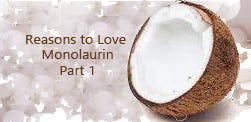Monolaurin is a truly amazing miracle of nature. I’ve publicly professed my love for this humble coconut oil-derived marvel on many occasions because it did for me what years of the strongest antibiotics failed to do. So first I’ll describe how it helped me and then delve into the many astonishing benefits, along with an important warning, of this unassuming, easily-missed remedy for so many of life’s ills.
What is Monolaurin?
Monolaurin, also known as glycerol monolaurate, is a medium-chain, fatty acid molecule—Technically a 12-carbon fatty acid monoester for both of you reading this right now who think organic chemistry is cool—And it has incredible properties. In addition to the metabolic and neurologic benefits we derive from medium-chain fatty acids, monolaurin goes many steps further—It has an enormous spectrum of antimicrobial activity against disease-causing bacteria, viruses, parasites, and fungi.
Lauric acid, a close chemical cousin to monolaurin, is a medium-chain fatty acid found in coconut oil and breast milk. Although lauric acid also has in vitro antimicrobial properties, monolaurin is far more potent. As such, monolaurin is effective in vivo—It protects mice from bacterial infection, whereas coconut oil, which is rich in lauric acid, does not.
Monolaurin is naturally occurring in human breast milk at 20 times the concentration found in cow’s milk, and for good reason—We’re helpless little drooling cherubs when we’re born. In the first few months of life, our immune systems are not well-developed, leaving us susceptible to infections from pretty much everything.
How awesome of Mother Nature to provide a fix for that.
Chronic Diseases—Infections as Root Cause for Many
As some of you may know, but many probably don’t, I got very sick from a bug bite—My illness broke me in nearly every conceivable way. More than just disabled from the daily routines of life due to maiming arthritis in most every joint, I was bedbound for over a year, unable to walk, sit up on my own, or lift my arms against gravity. Profoundly anemic with nightly fevers to 102F, and having lost 50 lbs, my resting heart rate was 120, going up to 180 with attempts to stand. Despite having told my story publicly so many times, it’s still difficult to admit to myself that I likely skirted the edges of death for the better part of 6 months. My personal medical history is included in one chapter of Chronic, a book devoted to the exploration of the usually-undiagnosed infections that underlie and cause a broad swath of chronic illnesses, most of which are often labeled as autoimmune.
Autoimmune diseases are veritable black holes in medical science. My diagnoses, most of which were “autoimmune,” included spondylitis, rheumatoid arthritis, uveitis, hemolytic anemia, fever of unknown origin, and POTS, among so many others. All are descriptive diagnoses, which means that they paint a picture of an illness but bring us no closer to figuring out its root cause. It’s shocking for most people to learn what chronic infections, many spread by bug bites (termed vector-borne infections), can do.
Happily, the majority of those who contract one or more of these myriad infections will never get as sick as I did. We’re evolutionarily adapted to fight them off fairly well—But still, there are tipping points. Many of us will be asymptomatic or minimally symptomatic until acquiring yet another, often more virulent, infection,—The straw that breaks the camel’s back—Or until something dysregulates our immune response, like Covid can do.
In my experience, reactivation of previously asymptomatic chronic infections is turning out to be a significant contributor to Long Covid. One example of a common, chronic bacterial infection spread by bug bites, which spans the continuum from asymptomatic to potentially fatal disease, is bartonellosis:
“Bartonellosis are diseases caused by any kind of Bartonella species. The infection manifests as asymptomatic bacteremia to potentially fatal disorders.”
I’m not saying that SARS-Cov2 isn’t sticking around in Long Covid patients, as there’s good evidence that it does. But I am saying that what we are recognizing as Long Covid is a complex process, likely involving multiple reactivated infections due to the immune dysregulation from persistent SARS-Cov2.
Long Covid has given scientists a window seat into the looking glass of chronic illness—They just have to peer deeply, past their own reflections—To see what lurks beneath.
Once the unseen is recognized, monolaurin becomes more valuable than gold and diamonds. To me, it’s like a trusted friend.
Keep reading with a 7-day free trial
Subscribe to ZeroSpin to keep reading this post and get 7 days of free access to the full post archives.



